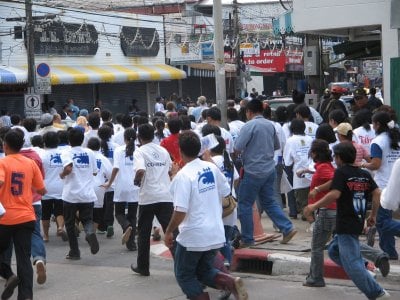Mixed reviews for tsunami drill

PATONG: The practice evacuation of the southern half of Patong Beach this morning received mixed reviews, from both tourists and the many government officials who attended.
Arriving by helicopter shortly after 10 am, Prime Minister Thaksin Shinawatra met a crowd of some 1,500 volunteer evacuees, many of them children wearing T-shirts made specially for the event.
Also on hand were diplomats from 22 countries, including the ambassadors of Germany, Austria, the UAE, Greece, Kazakhstan and Qartar. All were seated, along with other dignitaries, in a tent at the foot of Soi Bangla, from which they could view the evacuation from different angles by watching large-screen televisions.
In his speech, PM Thaksin said the drill was an important way to prevent loss of life should there be another natural disaster, and also to show the world that it is safe for tourists to return to Thailand’s Andaman coastline.
He added that the government would push ahead with its plan to install an early warning system using a network of offshore buoys, regardless of whether other countries chose to join in, because the safety of residents and tourists was its top priority.
The PM said that he was glad that information about tsunamis was now being included in school curricula, recalling how a 10-year-old schoolgirl on vacation at Mai Khao Beach was able to save her family and others because she had learned about tsunamis in her geography class.
“Here in Thailand, we didn’t learn about tsunamis until December 26,” he said.
PM Thaksin also commented that there weren’t enough signs indicating the evacuation routes. He later presented one such sign to Patong Mayor Pian Keesin.
After speeches by Minister of Tourism and Sport Somsak Thepsutin, Phuket Governor Udomsak Usawarangura and then himself, PM Thaksin pushed the button to begin the drill.
A series of loud siren calls began, each with about one-second duration and with an eerie, falling cadence. The volunteers began to run off the sand, along the beach road to Soi Bangla, and then outside the “risk zone”, defined as anything on the beach side of Rat-U-Thit 200 Pi Rd, which was as far as the December 26 tsunami waves reached.
The volunteers, photographed and filmed by the media, were pointed to safety and encouraged to move faster by rescue workers and police.
Meanwhile, a search and rescue mission was staged a few hundred meters offshore. Helicopters swooped in, dropping liferafts, flares and rescue personnel. Several jet-ski operators assisted.
The drill was declared a success 15 minutes after it had begun, with a loudspeaker announcing that all of the volunteers, both on land and floating at sea, had made it to safety. Later a voice message announced in different languages that it was safe for people to return to their hotels
A time of 20 minutes had been established as the period necessary to evacuate the beach before the arrival of the theoretical tsunami, assuming an earthquake of Richter magnitude 9.0 and with an epicenter near the Nicobar Islands.
After the drill finished, PM Thaksin noted that not everyone had participated in the exercise and that many onlookers, rather than taking part, had decided to join the VIPs and hundreds of members of the press corps in watching it.
“We should have had better cooperation from those who are not here in an official or work capacity,” he said.
Evacuation drills would need to be conducted at least twice a year, he added. The government budget for more warning towers to cover other parts of the island would be available by the end of 2006, he said.
Dr Smith Thammasaroj, head of the National Disaster Warning Center (NDWC), told the Gazette he was “about 70% satisfied” with the evacuation, but noted that it was only the first attempt and that he expected evacuation times to fall with more practice.
He noted that too many people had tried to reach safety by using cars or motorcycles, which increased the risk of accidents. A full-scale evacuation of Patong’s entire coastline would happen “very soon”, he added.
Not everyone was as impressed with the evacuation, however.
Australian tourist Allan Wybrow, who comes to Patong twice a year and is currently here on a three-month stay, told reporters that the drill hadn’t made him feel any safer.
“I know it was only a drill, but there were police standing around doing absolutely nothing, thinking it was a great joke … The siren is helpful, but you have to know the difference between the sounds, what each one means,” he added.
Phuket Tourist Association President Pattanapong Aikwanich said that there hadn’t been much time to organize the drill, but that it was crucial to let the world know that Phuket has an operational warning system so that tourists will return in the next high season.
He called on the government to provide greater support to the tourism industry, saying that average hotel occupancy rates in Phuket were currently at about 15%, an all-time low for the province. The situation in Phang Nga and Krabi was similar, he said.
Latest Thailand News
Follow The Thaiger on Google News:
























